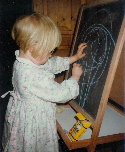publication date: Nov 9, 2007
|
author/source: Anne Coates
Under twos
As soon as your baby is
sitting up holding a spoon, he’s
ready to hold a
fat wax crayon in his fist and make his first delightful
squiggles.
Scribbling helps to develop
hand-eye co-ordination, just as
dipping their fingers into
new substances like paint or dough
encourages them to explore
texture and
shape.
 Age two to three
Age two to three
Scribbling starts to become
more varied and is beginning to move in a
circular direction as
grip and hand
control improve.
Offer a wider range of
pencils, crayons, paints and brushes as well as plastic shaped
biscuit cutters they can use with
dough.
Age three to four
Children are now involved in
drawing patterns and colouring which improves hand
muscle control and establishes the
correct grip for learning to write.
More structured painting
activities and printing
encourage the child to
experiment with colour.
Collage and and junk
modelling are popular and help them
explore shape and size.
Age four to five
Capable of longer periods of concentration,
pre-schoolers will be able to
produce more detailed pictures which
represent various objects and will enjoy using
stencils.
Encourage him to be more
adventurous with junk modelling and to
pay attention to detail.
Stuck for materials?
- Make your own finger paints using cornflour and water mixed into a paste and coloured with food dyes.
- Playdough - use three parts flour to one part salt then add a little cooking oil and enough water to make a dough. Colour with food colouring. Keeps for ages in a plastic bag.
- Saltdough - mix equal amounts of salt and flour plus oil and water as above. Knead until soft and stretchy. Can be hardened by cooking in the bottom of a low oven but will take a few hours to harden completely. Can be painted. Will keep uncooked in a plastic bag.
- Keep empty boxes and packets for junk modelling.
- Collect scraps of fabric and wool, buttons, feathers, cotton wool for making a collage.
- For a different type of collage use lentils, chick peas and other died pulses plus dry pasta shapes and experiment with sugar, flour, cocoa and rice for different textures.
Notes
Some
arts and crafts products are clearly
marked with an
age range. However these are only
guidelines. Be guided by your child’s
co-ordination and
development maybe he could easily use something
designed for an
older age range.
Children should always be
supervised during arts and crafts activities and you may need to be
extra vigilant when you are playing with children of
different ages - a four year old may be using something like
beads which a
younger one might put in her mouth and
swallow.
You should also be
prepared for different periods of
attentiveness - as a child gets older her
concentration span increases.